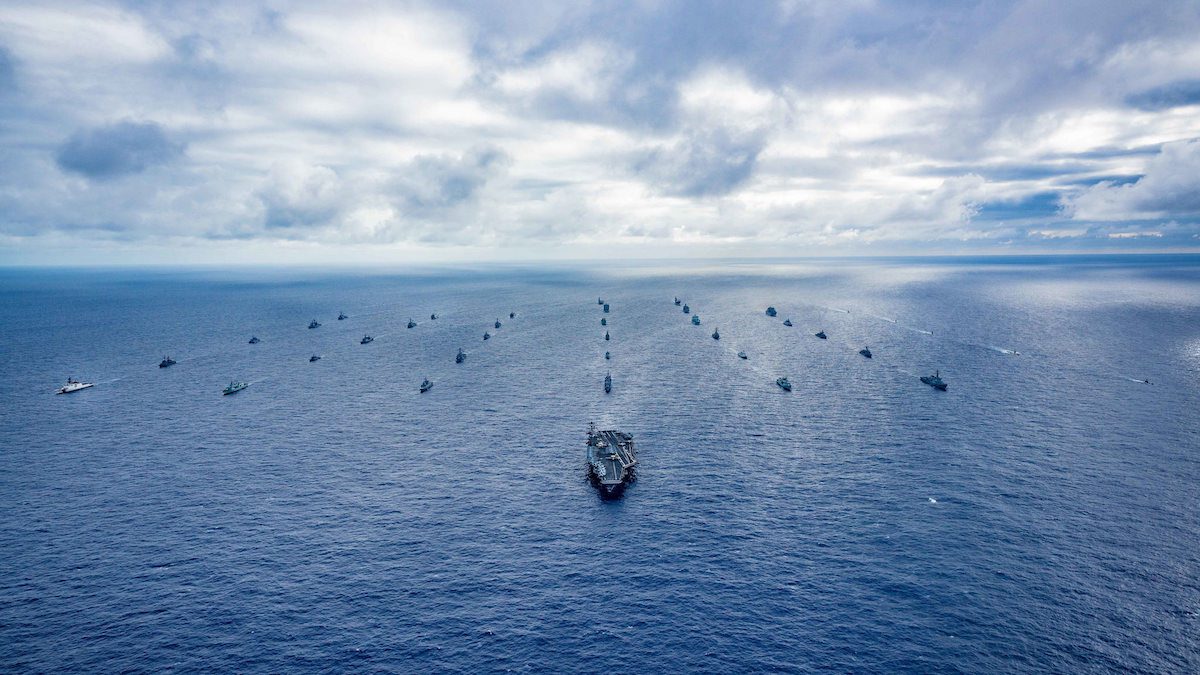Multinational navy ships and submarines steam in formation during a group sail off the coast of Hawaii, July 26, as part of exercise Rim of the Pacific (RIMPAC). (U.S. Navy/MC1 Arthurgwain L. Marquez)
The world’s largest international maritime exercise concluded this week following more than a month of training events conducted in and around the Hawaiian Islands and Southern California.
The biennial exercise, known as Rim of the Pacific, or RIMPAC for short, involved twenty-five nations and included 46 surface ships, five submarines, 17 land forces, and more than 200 aircraft and 25,000 personnel.
This year’s RIMPAC iteration marked the 26th in the series that began in 1971 and is now held every two years.
Hosted by U.S. Pacific Fleet, RIMPAC 2018 was led by U.S. Vice Adm. John D. Alexander, commander of the U.S. 3rd Fleet, who served as the combined task force (CTF) commander. Royal Canadian Navy Rear Adm. Bob Auchterlonie served as deputy commander of the CTF, and Japan Maritime Self-Defense Force Rear Adm. Hideyuki Oban was the vice commander. Fleet Marine Force was led by U.S. Marine Corps Brig. Gen. Mark Hashimoto. Other key leaders of the multinational force included Commodore Pablo Niemann of Armada de Chile, who commanded the maritime component, and Air Commodore Craig Heap of the Royal Australian Air Force, who commanded the air component.
Related: U.S. Was Right to Give China’s Navy the Boot: James Stavridis
“I couldn’t be more proud of our international team’s ability to successfully complete an exercise of this nature,” said Alexander. “Most importantly, we completed the exercise safely while still achieving national training objectives. This is a true testament to the talent and lasting partnerships we built through RIMPACs past and present, and will continue to build for the foreseeable future.”
Alexander said the involvement of so many different countries working together to successfully accomplish RIMPAC was a strong reminder of the unity coalition forces can exhibit in a real-world situation.
“Multinational operations are complicated,” he said. “It takes skill to assemble an international team and have it be successful. Throughout the duration of the exercise, from the planning conferences to the ships returning to port, this team proved they work great together and can adapt quickly to a dynamic environment.”
This year’s exercise included forces from Australia, Brunei, Canada, Chile, Colombia, France, Germany, India, Indonesia, Israel, Japan, Malaysia, Mexico, Netherlands, New Zealand, Peru, Republic of Korea, Republic of the Philippines, Singapore, Sri Lanka, Thailand, Tonga, United Kingdom, United States and Vietnam.
Additionally, for the first time since RIMPAC 2002, U.S. 3rd Fleet’s Command Center relocated from San Diego to Pearl Harbor to support command and control of all 3rd Fleet forces in 3rd Fleet’s area of responsibility, to include forces operating forward in the Western Pacific. The Fleet Command Center established at a deployable joint command and control on Hospital Point, Pearl Harbor, for the first part of the exercise and then transitioned to amphibious transport dock ship USS Portland (LPD 27) for the remainder of the exercise.
Auchterlonie said all participating nations worked together incredibly well to overcome various challenges and meet mission objectives.
“We had some weather systems and other realities, such as the second SINKEX target ship being sunk earlier than expected, that impacted our ability to complete all our training according to the plan, but that is also the great part about RIMPAC,” Auchterlonie said. “Our motto is ‘Capable, Adaptive, Partners’ and all the participating nations demonstrated this. We adjusted plans and drafted new ones in order to ensure each nation got the training value they expected from RIMPAC 2018.”
Participating nations and forces exercised a wide range of capabilities and demonstrated the inherent flexibility of maritime forces. These capabilities ranged from disaster relief and maritime security operations to sea control and complex warfighting. The relevant, realistic training program included amphibious operations, gunnery, missile, anti-submarine and air defense exercises, as well as counter-piracy operations, mine clearance operations, explosive ordnance disposal, and diving and salvage operations.
“This robust constellation of allies and partners support sustained and favorable regional balances of power that safeguard security, prosperity, and the free and open international order,” the U.S. 3rd Fleet said in statement. “RIMPAC 2018 contributes to the increased lethality, resiliency and agility needed by the joint and combined force to deter and defeat aggression by major powers across all domains and levels of conflict.”
Unlock Exclusive Insights Today!
Join the gCaptain Club for curated content, insider opinions, and vibrant community discussions.

 Join The Club
Join The Club







![A screengrab of a map showing an earthquake Mindanao, Philippines on Dec 2, 2023. (Image: US Geological Survey [USGS])](https://gcaptain.com/wp-content/uploads/2023/12/Screenshot-2023-12-02-at-10.45.17-AM-copy.png.webp)





